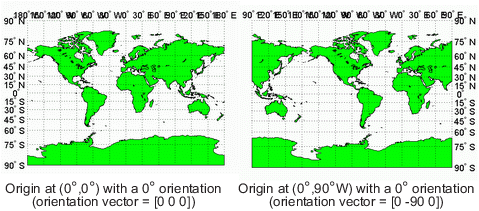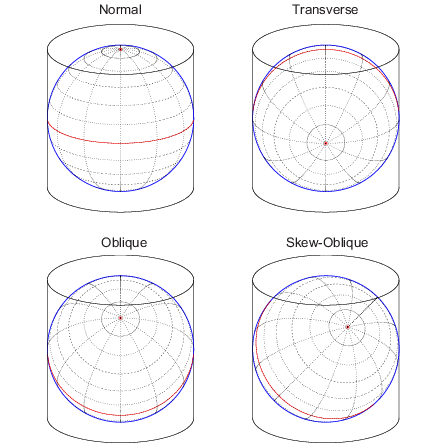Projection Aspect
A map projection's aspect is its orientation on the page or display screen. If north or south is straight up, the aspect is said to be equatorial; for most projections this is the normal aspect. When the central axis of the developable surface is oriented east-west, the projection's aspect is transverse. Projections centered on the North Pole or the South Pole have a polar aspect, regardless of what meridian is up. All other orientations have an oblique aspect. So far, the examples and discussions of map displays have focused on the normal aspect, by far the most commonly used. This section discusses the use of transverse, oblique, and skew-oblique aspects. For an example, see Control the Map Projection Aspect with an Orientation Vector.
Projection aspect is primarily of interest in the display of maps. However, this section also discusses how the idea of projection aspect as a coordinate system transformation can be applied to map variables for analytical purposes.
Note
The projection aspect discussed in this section is different from the
Aspect property of axesm-based maps. The
Aspect property of axesm-based maps controls the
orientation of the figure axes. For instance, if a map is in a normal
setting with a landscape orientation, a switch to a
transverse aspect rotates the axes by 90°, resulting in a
portrait orientation. To display a map in the transverse aspect,
combine the transverse aspect property with a -90° skew angle. The skew
angle is the last element of the Origin parameter. For example, a
[0 0 -90] vector would produce a transverse map.
The Orientation Vector
The Origin property of axesm-based maps is a
vector describing the geometry of the displayed projection. This property is called an
orientation vector (prior versions called it the origin
vector). The vector takes this form:
orientvec = [latitude longitude orientation]
The latitude and longitude represent the geographic coordinates of the center point of
the display from which the projection is calculated. The orientation refers to the clockwise
angle from straight up at which the North Pole points from this center
point. The default orientation vector is [0 0 0]; that is, the projection
is centered on the geographic point (0°,0°) and the North Pole is straight
up from this point. Such a display is in a normal aspect.
Changes to only the longitude value of the orientation vector do not change the aspect;
thus, a normal aspect is one centered on the Equator in latitude with an orientation of
0°.
Both of these Miller projections have normal aspects, despite having different orientation vectors:

This makes sense if you think about a simple, true cylindrical projection. This is the projection of the globe onto a cylinder wrapped around it. For normal aspects, this cylinder is tangent to the globe at the Equator, and changing the origin longitude simply corresponds to rotating the sphere about the longitudinal axis of the cylinder. If you continue with the wrapped-cylinder model, you can understand the other aspects as well.
Following this description, a transverse projection can be thought of as a cylinder wrapped around the globe tangent at the poles and along a meridian and its antipodal meridian. Finally, when such a cylinder is tangent along any great circle other than a meridian, the result is an oblique projection.
Here are diagrams of the four cylindrical map orientations, or aspects:

Of course, few projections are true cylindrical projections, but the concept of the wrapped cylinder is nonetheless a convenient way to describe aspect.
For an example that uses the orientation vector, see Control the Map Projection Aspect with an Orientation Vector.
Control the Map Projection Aspect with an Orientation Vector
The best way to gain an understanding of projection aspect is to experiment with orientation vectors. The following example uses a pseudocylindrical projection, the sinusoidal.
Create a default axesm-based map in a sinusoidal projection, turn on the graticule, and display the coast data set as filled polygons. The continents and graticule appear in normal aspect.
figure axesm sinusoid framem on gridm on tightmap tight load coastlines patchm(coastlat,coastlon,'g') title('Normal aspect: orientation vector = [0 0 0]')
![Figure contains an axes object. The axes object with title Normal aspect: orientation vector = [0 0 0] contains 4 objects of type patch, line.](../examples/map/win64/ExploringProjectionAspectExample_01.png)
Inspect the orientation vector from the axesm-based map. By default, the origin is set at (0°E, 0°N), oriented 0° from vertical.
getm(gca,'Origin')ans = 1×3
0 0 0
In the normal aspect, the North Pole is at the top of the image. To create a transverse aspect, imagine pulling the North Pole down to the center of the display, which was originally occupied by the point (0°,0°). Do this by setting the first element of Origin parameter to a latitude of 90°N. The shape of the frame is unaffected. This is still a sinusoidal projection.
setm(gca,'Origin',[90 0 0]) title('Transverse aspect: orientation vector = [90 0 0]')
![Figure contains an axes object. The axes object with title Transverse aspect: orientation vector = [90 0 0] contains 4 objects of type patch, line.](../examples/map/win64/ExploringProjectionAspectExample_02.png)
The normal and transverse aspects can be thought of as limiting conditions. Anything else is an oblique aspect. Conceptually, if you push the North Pole halfway back to its original position, that is, to the position originally occupied by the point (45°N, 0°E) in the normal aspect, the result is a simple oblique aspect. You can think of this as pulling the new origin (45°N, 0°) to the center of the image, the place that (0°,0°) occupied in the normal aspect.
setm(gca,'Origin',[45 0 0]) title('Oblique aspect: orientation vector = [45 0 0]')
![Figure contains an axes object. The axes object with title Oblique aspect: orientation vector = [45 0 0] contains 4 objects of type patch, line.](../examples/map/win64/ExploringProjectionAspectExample_03.png)
The previous examples of projection aspect kept the aspect orientation at 0°. If you alter the orientation, an oblique aspect becomes a skew-oblique orientation. Imagine the previous example with an orientation of 45°. Think of this as pulling the new origin (45°N,0°E), down to the center of the projection and then rotating the projection until the North Pole lies at an angle of 45° clockwise from straight up with respect to the new origin. As in the previous example, the location (45°N,0°E) still occupies the center of the map.
setm(gca,'Origin',[45 0 45]) title('Skew-Oblique aspect: orientation vector = [45 0 45]')
![Figure contains an axes object. The axes object with title Skew-Oblique aspect: orientation vector = [45 0 45] contains 4 objects of type patch, line.](../examples/map/win64/ExploringProjectionAspectExample_04.png)
The base projection can be thought of as a standard coordinate system, and the normal aspect conforms to it. The features of a projection are maintained in any aspect, relative to the base projection. As the preceding illustrations show, the outline (frame) does not change. Nondirectional projection characteristics also do not change. For example, the sinusoidal projection is equal-area, no matter what its aspect. Directional characteristics must be considered carefully, however. In the normal aspect of the sinusoidal projection, scale is true along every parallel and the central meridian. This is not the case for the skew-oblique aspect; however, scale is true along the paths of the transformed parallels and meridian.
Any projection can be viewed in alternate aspects and this can often be quite useful. For example, the transverse aspect of the Mercator projection is widely used in cartography, especially for mapping regions with predominantly north-south extent. One candidate for such handling might be Chile. Oblique Mercator projections might be used to map long regions that run neither north and south nor east and west, such as New Zealand.